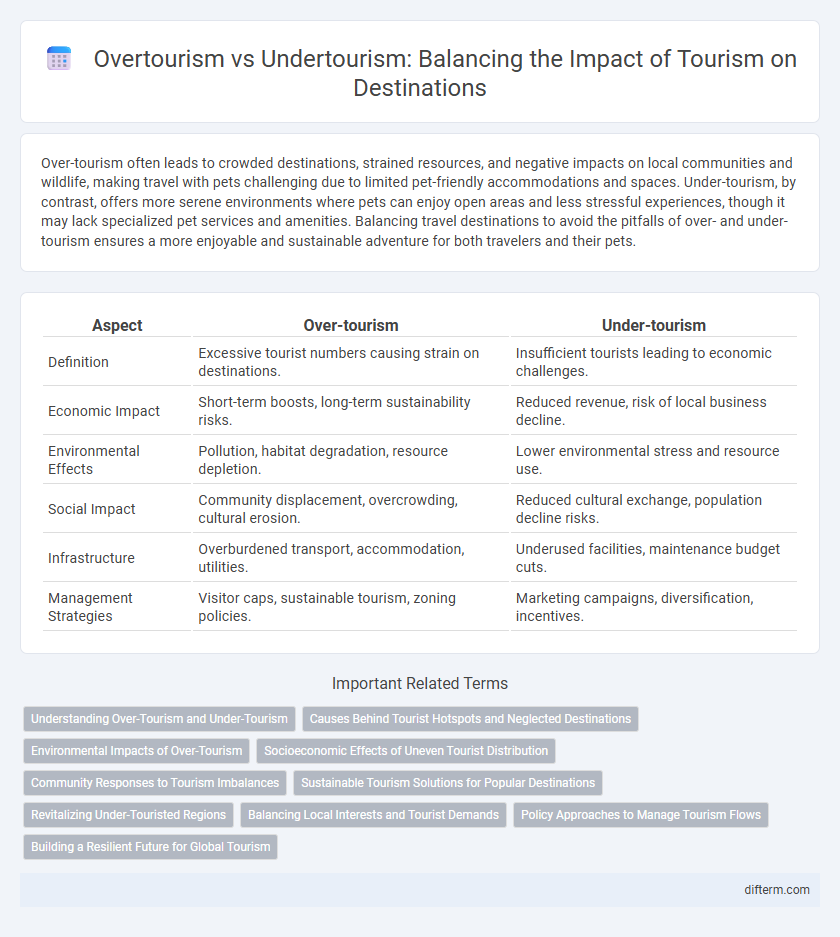Over-tourism often leads to crowded destinations, strained resources, and negative impacts on local communities and wildlife, making travel with pets challenging due to limited pet-friendly accommodations and spaces. Under-tourism, by contrast, offers more serene environments where pets can enjoy open areas and less stressful experiences, though it may lack specialized pet services and amenities. Balancing travel destinations to avoid the pitfalls of over- and under-tourism ensures a more enjoyable and sustainable adventure for both travelers and their pets.
Table of Comparison
| Aspect | Over-tourism | Under-tourism |
|---|---|---|
| Definition | Excessive tourist numbers causing strain on destinations. | Insufficient tourists leading to economic challenges. |
| Economic Impact | Short-term boosts, long-term sustainability risks. | Reduced revenue, risk of local business decline. |
| Environmental Effects | Pollution, habitat degradation, resource depletion. | Lower environmental stress and resource use. |
| Social Impact | Community displacement, overcrowding, cultural erosion. | Reduced cultural exchange, population decline risks. |
| Infrastructure | Overburdened transport, accommodation, utilities. | Underused facilities, maintenance budget cuts. |
| Management Strategies | Visitor caps, sustainable tourism, zoning policies. | Marketing campaigns, diversification, incentives. |
Understanding Over-Tourism and Under-Tourism
Over-tourism occurs when a destination experiences excessive visitor numbers, leading to environmental degradation, cultural erosion, and strain on infrastructure. Under-tourism, conversely, refers to locations with untapped potential, where insufficient tourist activity results in economic stagnation and underdeveloped local businesses. Balancing tourism levels involves managing visitor flows to sustain community well-being while maximizing economic benefits.
Causes Behind Tourist Hotspots and Neglected Destinations
Tourist hotspots often experience over-tourism due to factors such as accessibility, well-developed infrastructure, and aggressive marketing campaigns that attract large crowds. In contrast, neglected destinations suffer from under-tourism because of limited transportation options, lack of promotional efforts, and inadequate facilities deter potential visitors. Economic disparities and regional instability further amplify the divide between popular and overlooked travel locations.
Environmental Impacts of Over-Tourism
Over-tourism leads to severe environmental degradation, including habitat loss, increased waste, and water pollution in popular destinations. The excessive foot traffic damages fragile ecosystems, accelerates soil erosion, and disrupts wildlife behavior. Sustainable management strategies are critical to mitigating these impacts and preserving natural landscapes for future generations.
Socioeconomic Effects of Uneven Tourist Distribution
Over-tourism concentrates economic benefits in crowded areas, leading to inflated property prices and strained public services, while residents often face reduced quality of life. Under-tourism causes economic stagnation in less-visited regions, limiting job opportunities and infrastructure development. Balanced tourist distribution supports sustainable economic growth and equitable social benefits across destinations.
Community Responses to Tourism Imbalances
Communities facing over-tourism implement measures such as visitor caps, local tourism taxes, and promotion of off-peak travel to alleviate strain on infrastructure and preserve cultural identity. Conversely, areas suffering from under-tourism invest in marketing campaigns, infrastructure development, and partnerships with travel influencers to attract visitors and stimulate economic growth. Effective community responses balance tourism flows, ensuring sustainable development and enhanced quality of life for residents.
Sustainable Tourism Solutions for Popular Destinations
Popular destinations facing over-tourism implement sustainable tourism solutions such as visitor caps, promoting off-peak travel, and investing in eco-friendly infrastructure to protect natural and cultural resources. Under-tourism areas encourage responsible travel by enhancing local amenities, marketing unique experiences, and supporting community-based tourism initiatives to distribute visitor flow evenly. Balancing these strategies fosters long-term economic benefits while preserving environmental integrity and cultural heritage.
Revitalizing Under-Touristed Regions
Revitalizing under-touristed regions addresses economic disparities by promoting sustainable travel and unlocking hidden cultural and natural attractions. Innovative marketing strategies and infrastructure improvements are key to attracting visitors while preserving local ecosystems and heritage. This balanced approach reduces over-tourism pressures in popular destinations and fosters inclusive growth in emerging travel hotspots.
Balancing Local Interests and Tourist Demands
Balancing local interests and tourist demands requires managing over-tourism's strain on infrastructure and natural resources while addressing under-tourism's economic shortfalls. Implementing sustainable tourism policies, such as visitor caps and promoting off-peak travel, helps preserve cultural heritage and environmental quality. Empowering local communities through participatory planning ensures tourism benefits local economies without compromising residents' quality of life.
Policy Approaches to Manage Tourism Flows
Effective policy approaches to manage tourism flows balance over-tourism and under-tourism by implementing sustainable visitor limits, zoning regulations, and diversified destination promotion. Governments invest in infrastructure upgrades and community engagement initiatives to mitigate environmental impact and support local economies. Digital tools and data analytics enable real-time monitoring of tourist volumes, facilitating dynamic management of high-traffic areas and encouraging off-peak travel.
Building a Resilient Future for Global Tourism
Balancing over-tourism and under-tourism is critical for building a resilient future in global tourism by promoting sustainable visitor distribution and preserving cultural heritage sites. Implementing data-driven strategies enhances destination management, mitigating environmental degradation and supporting local economies. Emphasizing community engagement and diversified tourism offerings ensures long-term viability and resilience against economic and ecological challenges.
Over-tourism vs Under-tourism Infographic

 difterm.com
difterm.com